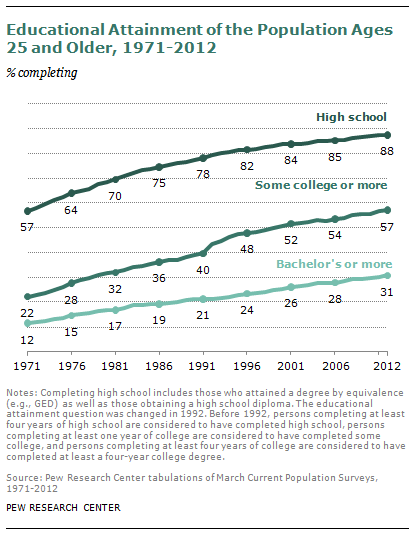
Using the criteria of high school and college completion, U.S. adults are better educated than ever before. In 2012, 31% of all adults ages 25 and older have completed at least a bachelor’s degree, up from 30% in 2011. In 1971 only 12% of adults ages 25 and older had completed at least a four-year college degree.
In 2012 57% of adults ages 25 and older had finished at least some college education (including those finishing a bachelor’s or associate degree as well as those completing college credits but not a degree). This matched the level attained in 2011. In 1971 only 22% of adults had finished at least some college. The rising share of adults with some college education is reflective, at least in part, of the development of mass higher education in the U.S.
A high school education is becoming increasingly universal. In 2012, 88% of adults ages 25 and older had at least completed high school, matching the 2011 level and far surpassing the 57% of adults who had at least finished high school in 1971.
Changes in educational attainment among the overall population are linked to a number of demographic factors – some working at cross purposes. Over time, older, less educated cohorts have died off. This has tended to boost the overall attainment of the remaining population. At the same time, the influx of new immigrants has changed the demographic makeup of the population. In the latter part of the 20th century, immigrants have tended not to be better educated than the native population (except perhaps at the highest levels of educational attainment) and thus have not contributed to the overall rise in educational attainment (Betts and Lofstrom, 2000; Little and Triest, 2001). In the last few years, however, newly arrived immigrants to the United States have tended to be better educated than the native population, partly reflecting the growing importance of immigrants from Asia in the immigration flow. More than 40% of recently arrived immigrants to the U.S. ages 25 to 64 have completed at least a bachelor’s degree (Pew Research Center, 2012).
A common way to adjust for the changing age structure of the population is to focus on the educational attainment of a narrow age group. The remainder of this report follows U.S. Census Bureau practice and focuses on the educational attainment of 25- to 29-year-olds. While these young adults have not necessarily completed their education, they do serve as a recent indicator of the levels of U.S. educational attainment.




